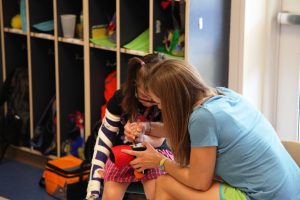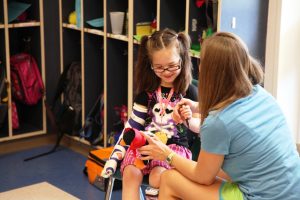Each June a therapeutic summer day camp led by Holly Holland, senior pediatric occupational therapist at the N.C. Children’s Hospital, offers constraint-induced movement therapy to kids ages 3 to 10. Thanks to the work of Holland and her volunteers at ‘Helping Kids with Hemiplegia,’ children like six-year-old Peyton Wolforth of Fort Bragg are learning to use their affected limbs.

Each June a therapeutic summer day camp led by Holly Holland, senior pediatric occupational therapist at the N.C. Children’s Hospital, offers constraint-induced movement therapy to kids ages 3 to 10. Thanks to the work of Holland and her volunteers at ‘Helping Kids with Hemiplegia,’ children like six-year-old Peyton Wolforth of Fort Bragg are learning to use their affected limbs.


by Zach Read – zread@unch.unc.edu
Peyton’s diagnosis of left hemiplegia from a right prenatal stroke and shunted hydrocephalus makes it difficult for her to perform everyday functions with her left hand. Routine tasks like buttoning clothes, for example—things that many people take for granted—present significant challenges for her. But after recently completing her third year in the summer camp, Peyton’s hand is functioning better than ever.
“She’s far more aware of that hand,” says Alison Wolforth, Peyton’s mother. “Her affected hand, when we first started, was very fisted. She didn’t use it unless she absolutely had to. After three years in the camp, along with her other therapies, she’s starting to use it without needing anybody to tell her that she should.”
Hemiplegia is a condition that involves motor impairment and severe weakness of the limbs on one side of the body. When Holland established Helping Kids with Hemiplegia in 2005, her goal was to provide impacted children with constraint-induced movement therapy (CIMT) in a fun, camp setting.
CIMT immobilizes the patient’s able arm, placing it in a cast, while rehabilitating the affected arm through focused activities and exercises. Although CIMT is particularly effective as a therapy for adult stroke victims, it had rarely been used on children. The results are striking. Recently Peyton has accomplished tasks such as tying her own shoes, and has done so before other kids her age, including her twin sister. Improved use of her hand is especially noticeable, her mother says, in the days and weeks after the camp.
“Right after the camp, she’s reaching for things using her left hand,” says Wolforth. “She even does so at the hotel during the week of the camp, and she doesn’t even realize that she’s doing it.”
Holland knew that building support for Helping Kids with Hemiplegia would take time, but once children and families experienced the benefits of CIMT, word about the camp would spread.
“It’s somewhat outside the box to do this,” says Holland, whose campers spend ten days working with her and her staff at Mary Scroggs Elementary School in Southern Village in Chapel Hill. “So we started out small—we had 15 kids the first year—and we only did it for five days. It’s gotten progressively larger.”
Today the camp welcomes approximately 38 kids. The therapeutic activities those campers undergo can be difficult, so Holland spends a lot of time creating activities that will be fun for them. During the week, she holds theme days in which everyone dresses up as a superhero or a pirate. Last week, on Pirate Day, kids searched for gold to work on grasp strength, pinching, and visual scanning, and held sword fights to work on weight shifting and separating their arms from their bodies. The camp even hosted Dog Day, during which children worked with therapeutic dogs.
“Mixing in theme days makes it more fun,” says Holland. “It makes it a camp. We’re doing a lot of hard work. We have some days that are ‘work days’ when we just have the normal activities. But you have to be creative to get kids to do this for six hours per day, wearing the cast the whole time.”
Other activities include working on wrist movements and finger strength by hammering golf tees into Styrofoam and pulling them out; improving sensory input by hiding objects in rice, beans, and hair gel and searching for them; and improving isolated finger movements and finger strength through various games.
While the children are the central focus of the camp, the benefits of Helping Kids with Hemiplegia are acutely felt by the children’s families. Campers come from all corners of North Carolina, and their families stay together and get to know each other during the course of the week.
“That’s not something I really thought about when I started the camp, but most of the families are from North Carolina and have been able to form their own networking system,” says Holland. “They get to talk to people whose kids have similar problems, which has been great for them.”
The Wolforths and other families appreciate the chance to meet each other and are eager to maintain connections with them after the camp ends, using social media and other ways of staying in touch.
“We’re close with the other families,” Alison Wolforth says. “Siblings enjoy meeting each other and talking, the campers spend time together outside of camp, and the parents get together in the parent room or at the hotel and share stories and talk about what works for us. Knowing that someone else has exactly what your child has and that there are people going through the same things as you makes it a little bit easier.”
Unfortunately, because CIMT is fairly new in pediatrics, many insurance companies consider it experimental therapy and don’t reimburse patients’ families for its use. The few programs that incorporate CIMT for children can cost up to $20,000. But with the generous support of donors and promise grants from the Children’s Hospital’s fundraising arm, the N.C. Children’s Promise, the camp is virtually free for children’s families.
“Donations make it viable,” says Holland. “Our kids are not charged a fee for the camp because I don’t want anybody to not be able to come.”
Families are grateful for the camp’s affordability and accessibility.
“We’re a military family,” says Wolforth. “Although we have really good insurance for most things, it won’t cover this. We’ve never been able to afford to go to any of the other camps or programs because they’re so expensive. Holly works so hard to make this affordable to everybody—even the hotel rooms are offered at a reduced rate.”
Key to the camp’s affordability is the work of student volunteers who come from universities all over the state and beyond. The 2013 volunteers came from UNC, Duke, Elon, Winston-Salem State, and Ohio State, among others. Most of the students are training in occupational therapy or physical therapy, while some student volunteers from UNC participate in a pre-OT/PT club and hope one day to get into school.
“We’ve been doing this for eight years and now the word is out,” says Holland. “Students know we’re here and that it’s a good learning opportunity for them, so it’s a win-win—they win by coming to the program as volunteers and learning a lot, and the kids win because without the students, we couldn’t have this program. Paying therapists to do this wouldn’t be affordable.”
Not only has word reached students interested in OT/PT—research is beginning to show the positive impact of CIMT on children.
“We just completed a research study with the Department of Neurology in which 15 of these kids were followed for a year,” says Holland. “They had a scan of the brain at three, six, and nine months before and after the camp. We saw measurable changes in their MRIs because of this intervention.”
As CIMT use continues to grow among therapists treating children, Holland’s goal for each individual child remains clear: she wants them to become more functional in everything they do.
“We want them to leave here knowing that they can use two hands and have better strength in their tummy and trunk,” says Holland. “We also want their parents to learn more ways to motivate them to try to do things using their involved side and to get them into activities that are age-appropriate. I want them to be independent, to do all those things that are two-handed, and be like regular kids as much as possible.”
While children are benefiting from Holland’s incorporation of CIMT, the camp would not exist if not for the special connection she shares with the children she treats.
“She has such a genuine love for all these kids,” says Wolforth. “It’s amazing the amount of time and effort she puts in. She fundraises, thinks things through, and plans so much fun for them. She’s a phenomenal woman.”